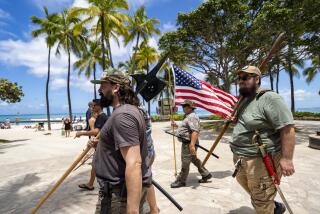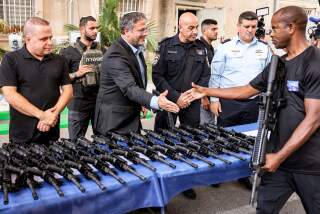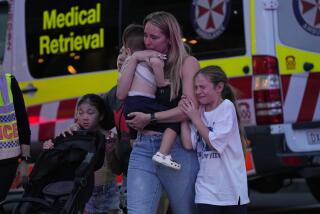Anti-Gun Program a Smashing Success
- Share via
SYDNEY, Australia — Swinging a hammer, Al Egan hacks at a semiautomatic rifle. Soon the gun is dismembered--the barrel, the wooden butt and metal parts are strewn on his workbench.
Around him, in a room ringing with hammer blows, Egan’s mates destroy an endless line of rifles and shotguns sent by a conveyor belt.
“A lot of engineering has gone into some of these beautiful pieces, but destroying them does good for everyone,” Egan says. He and his 14 colleagues demolish about 1,000 guns each day.
For the last year, responding to the worst massacre by a lone gunman in history, Australia has pushed ahead with a unique and ambitious plan to buy military-style rapid-fire rifles from civilians and destroy them.
The work is done at a police facility in a quiet Sydney neighborhood. The location is not advertised because police don’t want thieves raiding the arsenal.
Officials say the guns are broken up with hammers because it would be too complicated to develop machines that could handle the variety of sizes and materials. The metal parts are melted for use in making such products as paper clips and toys, and the wood and plastic also are recycled.
Australia outlawed semiautomatic rifles and shotguns and pump action shotguns last June, only a few weeks after a deranged gunman wielding assault rifles killed 32 tourists and townspeople at Port Arthur, Tasmania.
The gunman, Martin Bryant, barricaded himself in an inn with three hostages, burning them to death the next day. He was captured, pleaded guilty and is imprisoned for life.
In October, an amnesty was announced to let civilians sell their high-power guns to the government--no questions asked--at retail market price, regardless of the weapons’ age or condition.
It is the first time any nation has tried such a program.
So far, the government has paid the equivalent of $156 million for more than 380,000 firearms that Australians have turned in at police stations across the country, said Mick Roelandts, the program’s police manager. In all, 1 million firearms are expected to be turned in by the time the amnesty ends Sept. 30, he said.
Among the weapons turned in were four plastic-barreled “orange cannons,” usually used by fishermen to throw bait and line far into the water. But gangsters use them to fire frozen oranges, which at a distance of about 100 feet can blow a hole through a person.
“It is costing the Australian society a lot of dollars, it is true. But tragedies like Port Arthur cost the society a lot more not just in terms of money, but in trauma,” he said.
The most expensive guns that police have purchased were four Italian-made Cosmi shotguns, often described as the Rolls-Royce of firearms. They cost the government $23,400 each.
Describing himself as “stumped by the variety of weapons in Australia,” Roelandts said private owners, collectors, dealers and criminals also have surrendered a range of machine guns, including Uzis, Sten guns and Brownings. Such weapons were long illegal.
Police Sgt. Peter Starling is an ardent gun lover and used to teach police officers how to shoot before taking his new job as deputy director of the destruction facility. “It is a shame to see some of the guns broken. But we have to get them out of society’s way.”
That sentiment was widespread in Australia after the Port Arthur massacre, helping Prime Minister John Howard overcome the resistance of gun ownership groups to limiting civilian weapons.
Under the new law, farmers who have to kill vermin may own semiautomatic guns, and professional target shooters may keep their sporting guns. Handguns remain freely available even though ownership is highly regulated.
Until last year, three of Australia’s seven states did not require owners to register semiautomatic guns, so no one is sure how many such weapons are in Australia.
The National Coalition for Gun Control, a private lobbying group, estimates that there are 4 million guns of all types, one for every 4.5 people. In the United States, there are enough guns to put one in the hand of every citizen.
More to Read
Sign up for Essential California
The most important California stories and recommendations in your inbox every morning.
You may occasionally receive promotional content from the Los Angeles Times.










